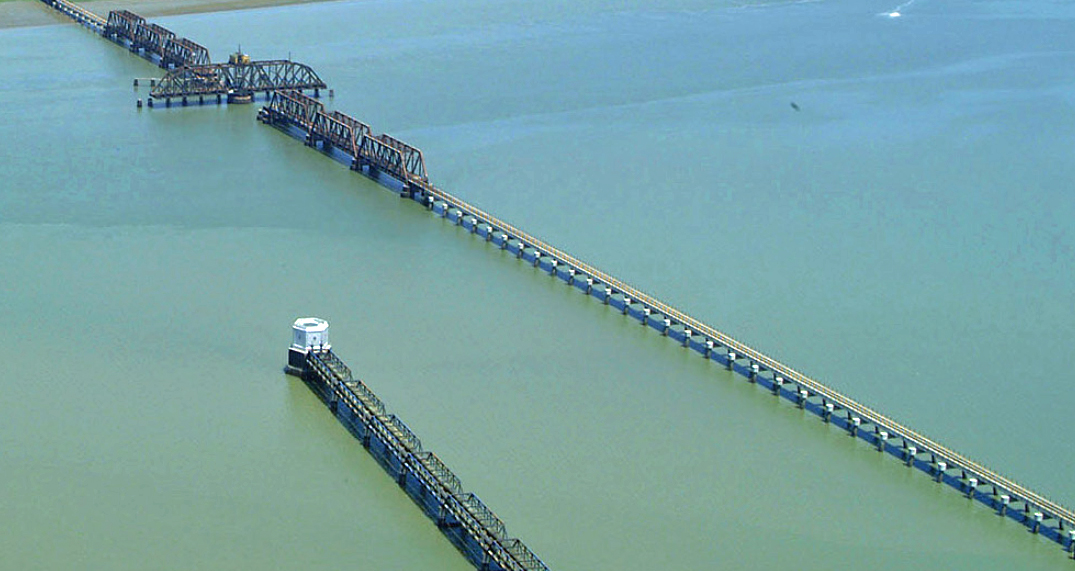A billboard-sized sign off Middlefield Road a few blocks from Costco proclaims “Redwood Junction.” I wondered why it doesn’t say “Redwood City Junction.” Then I remembered that Redwood City has gone through a variety of names: Embarcadero, Mezesville and Redwood.
Redwood Junction, I found out, is a neighborhood of about 2,600 people that is literally a junction for train tracks. There was a time when the tracks went across the bay on the now long abandoned Dumbarton Rail Bridge. Backers of plans to resurrect the span look forward to the day when commuters no longer clog freeways with cars but move from one place to another by train. Their high hopes are nothing compared to those who hailed the opening of the Dumbarton span in 1910.
“The distance from Oakland to San Francisco by way of the bridge is 26 miles less than by way of San Jose,” Frona Colburn wrote in a long column in the July 4, 1910, Redwood City Democrat.
She was more concerned about what the bridge, the first on San Francisco Bay, would do for freight trains than for passengers, who seemed to be treated as an afterthought in the article. Her attitude was not surprising when one takes into account that at the time most people worked near their homes. The important contribution of the new bridge was that it meant “a great savings of time and simplifies the handling of freight cars.”
There would be no need for what Colburn referred to as “trans-bay freight boats.”
The Early Years
Freight trains dominated future business on the Dumbarton Bridge, named for Dumbarton Point, the span’s western terminus. From 1912 to at least 1918, however, there was passenger service. In addition, there were some trains made up of both freight and passenger cars. There are still some old Dumbarton passenger timetables around that show trains ran from Newark to Redwood City where passengers could transfer for San Francisco or San Jose. The optimistic Colburn forecast that “electric trains” would offer service “every ten minutes.” Didn’t happen. What Colburn didn’t, or couldn’t, see was the future importance of the automobile. Cars and trucks, in just 10 years, had a huge impact on railroads.
In 1927 a two-lane vehicle bridge opened adjacent to the rail bridge. In 1982 a four-lane bridge took over. Two years later, the center section of the 1927 bridge was demolished in a controlled explosion. The railroad bridge is only five miles long and has been out of service since the 1980s. On January 2, 1998, a fire hit the abandoned structure that had seen the last freight train roll over its tracks in 1982. The blaze collapsed the western approach, but the span’s swinging section, which rotated to make way for boats, still stands, left in the open position.
A Passage for Boats
In the bridge’s heyday, boaters would signal the bridge operator who used a diesel engine to twist the section so vessels could pass. There is also a much smaller freight bridge, one that crossed Newark Slough on the east side of the bay toward Fremont. About 100 yards of that single track span went up in flames in 2019. Repairing and getting the rail bridge in working order is only one part of a massive plan called the Dumbarton Rail Corridor project, which totals 20.5 miles.
The Bay Rail Alliance recommended that three new passenger rail stations should be built. Proposed service calls for six trains across the bridge during the morning commute and six during the evening. Morning trains would originate at Union City, cross the bay, and then three trains would travel north to San Francisco and three proceed south to San Jose along Caltrain tracks. All trains would reverse patterns and return to Union City at the end of their run.
“Other service patterns and frequency would be possible in the future as the service gains popularity,” the alliance said on its website.
How’s that for optimism? Perhaps Colburn wasn’t too far off track in 1910.






